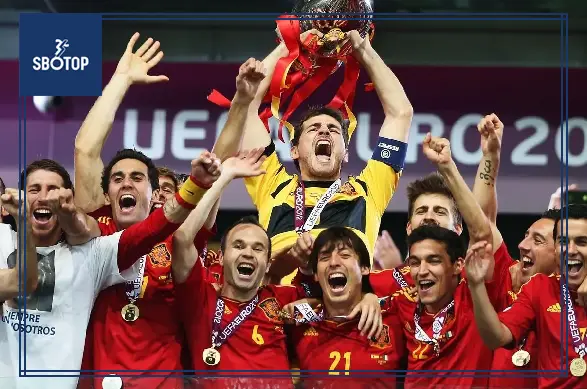The EURO 2012 final on July 1st in Kyiv was not just a football match; it was a historic display of tactical brilliance, team cohesion, and individual skill. Spain’s resounding 4-0 victory over Italy cemented their status as one of the greatest football teams ever assembled. This comprehensive analysis explores the factors that contributed to Spain’s overwhelming success in this crucial match, providing insights into the strategies employed and the broader implications of their triumph.
Pre-Match Expectations
Coming into the EURO 2012 final, Spain was both the defending European champions and the world champions, having won EURO 2008 and the 2010 FIFA World Cup. Under the guidance of coach Vicente del Bosque, Spain had continued to evolve their renowned tiki-taka style of play, characterized by short passing and movement, maintaining possession, and pressing when lost. Despite their success, there were critics who claimed Spain’s style had become predictable and overly cautious.
Italy, managed by Cesare Prandelli, had surprised many by reaching the final, notably after a convincing 2-1 victory against Germany in the semi-finals. The Italians were praised for their robust defensive strategies paired with effective counter-attacking prowess, led by the veteran Andrea Pirlo and the dynamic Mario Balotelli.
The Tactical Setup
- Spain’s Formation and Approach:Del Bosque opted for a 4-3-3 formation but with a twist—instead of a traditional striker, Cesc Fàbregas was utilized as a false nine. This decision was crucial as it allowed Spain to overload the midfield and retain possession effectively, confusing the Italian defense and disrupting their structural compactness.
The midfield trio of Xavi, Andrés Iniesta, and Sergio Busquets played pivotal roles. Xavi’s ability to control the tempo and Iniesta’s dribbling and penetrating passes posed constant threats. Busquets provided the defensive balance, shielding the backline and recycling possession.
Italy’s Game Plan:
Prandelli set up Italy in a 4-4-2 formation, hoping to utilize Daniele De Rossi and Claudio Marchisio’s energy in midfield to disrupt Spain’s rhythm. The plan was to rely on Pirlo’s deep-lying playmaking and exploit the pace of Balotelli and Antonio Cassano upfront through quick breaks.
The Match Unfolds
From the kickoff, Spain executed their possession-based strategy to perfection. The early goal in the 14th minute by David Silva, heading in a superb cross from Iniesta, set the tone. Spain’s dominance in possession (about 60% throughout the match) and their meticulous passing dismantled Italy’s tactical setup, preventing the Italians from establishing any rhythm.
Jordi Alba’s goal in the 41st minute further exemplified Spain’s dominance. A brilliant one-two with Xavi led to Alba sprinting half the length of the pitch to receive the return pass and coolly slotting the ball past Gianluigi Buffon, the Italian goalkeeper. This goal showcased Spain’s ability to blend their possession with direct attacking when needed, highlighting their tactical flexibility.
The second half saw Italy trying to respond, but their hopes were dashed as Thiago Motta, who had come on as the third substitute, suffered an injury after Italy had used all their substitutions, reducing them to ten men. Spain capitalized on the numerical advantage, and their continuous pressing and quick interchanges kept the Italian side chasing shadows.
Fernando Torres came off the bench to add the third goal in the 84th minute, becoming the first player to score in two EURO finals. He then assisted Juan Mata four minutes later for the fourth goal, sealing a historic victory for Spain.
Key Factors in Spain’s Victory
Tactical Mastery:
- Del Bosque’s strategy to use a false nine disrupted Italy’s defensive plans and allowed Spain to control the midfield comprehensively. The fluid movement of Spain’s attackers left the Italian defenders unable to mark effectively.
Midfield Dominance:
- The trio of Xavi, Iniesta, and Busquets dictated the pace and flow of the game. Their ability to retain possession under pressure and their precise passing proved too much for the Italian midfield to handle.
Defensive Solidity:
- Spain’s defense, led by Sergio Ramos and Gerard Piqué, was impenetrable, neutralizing the threat from Balotelli and Cassano and giving Spain the platform to build attacks confidently.
Psychological Advantage:
- Spain’s early goal unsettled Italy and gave Spain the confidence to play their natural game without the anxiety of a knockout match. The psychological boost of leading from the front allowed Spain to play with more freedom and creativity.
Legacy of the Victory
Spain’s triumph in the EURO 2012 final was more than just a retention of the European Championship; it was a validation of their football philosophy. By winning three consecutive major tournaments, Spain not only etched their names in the history books but also influenced a generation of players and coaches across the globe. The principles of possession, pressing, and playing out from the back became integral to football curriculums worldwide, testament to the profound impact of Spain’s golden era.
The EURO 2012 final was a masterclass in modern football by Spain, orchestrated by the tactical genius of Vicente del Bosque and executed flawlessly by a squad of exceptionally skilled players. This match not only reaffirmed Spain’s dominance on the international stage but also redefined notions of how football could be played. It stands as a beacon of strategic brilliance, collective effort, and footballing philosophy, continuing to inspire and instruct future generations in the beautiful game.
Also Read:







